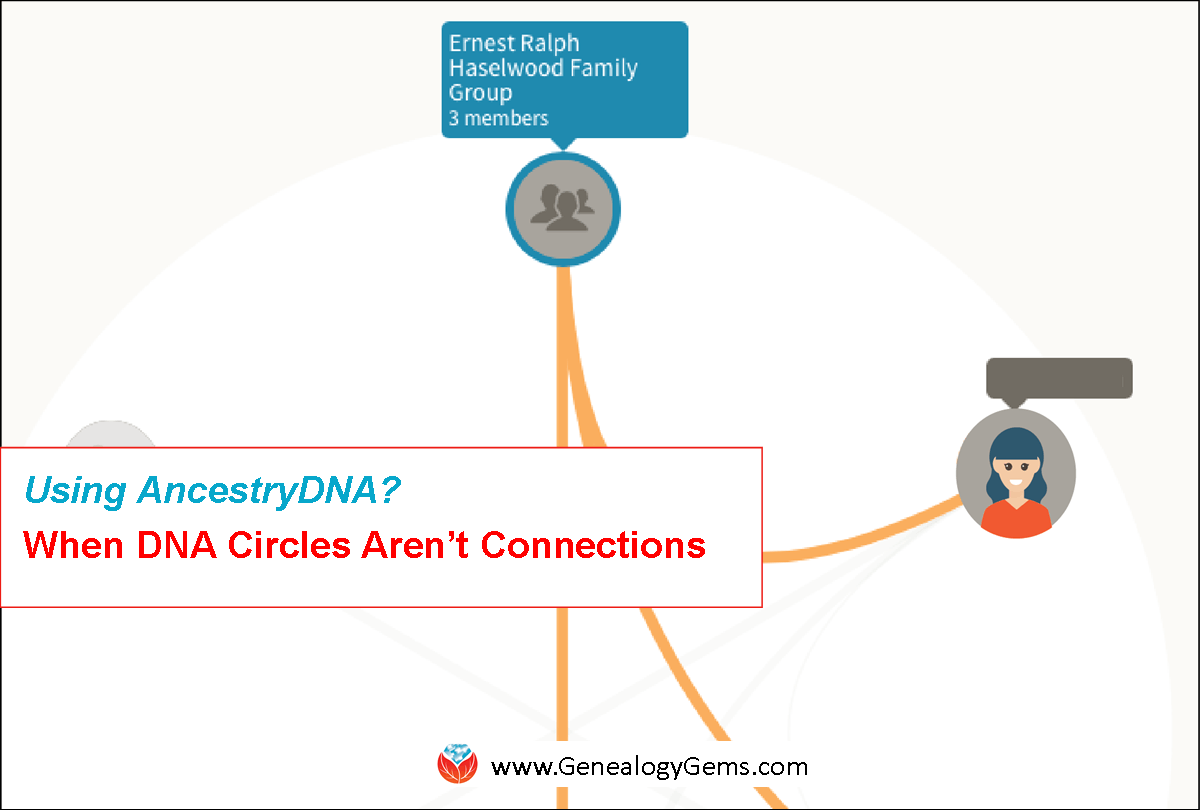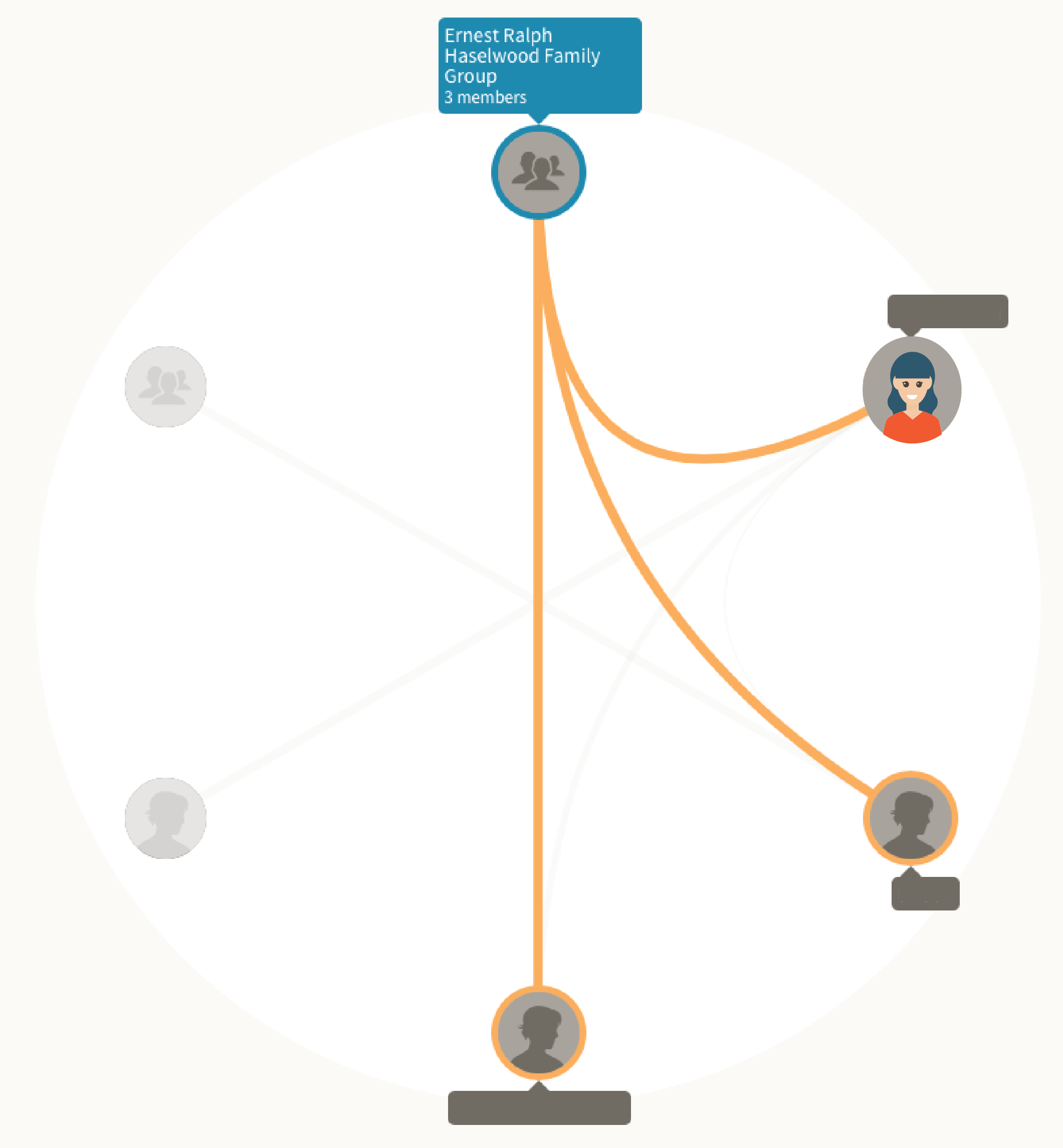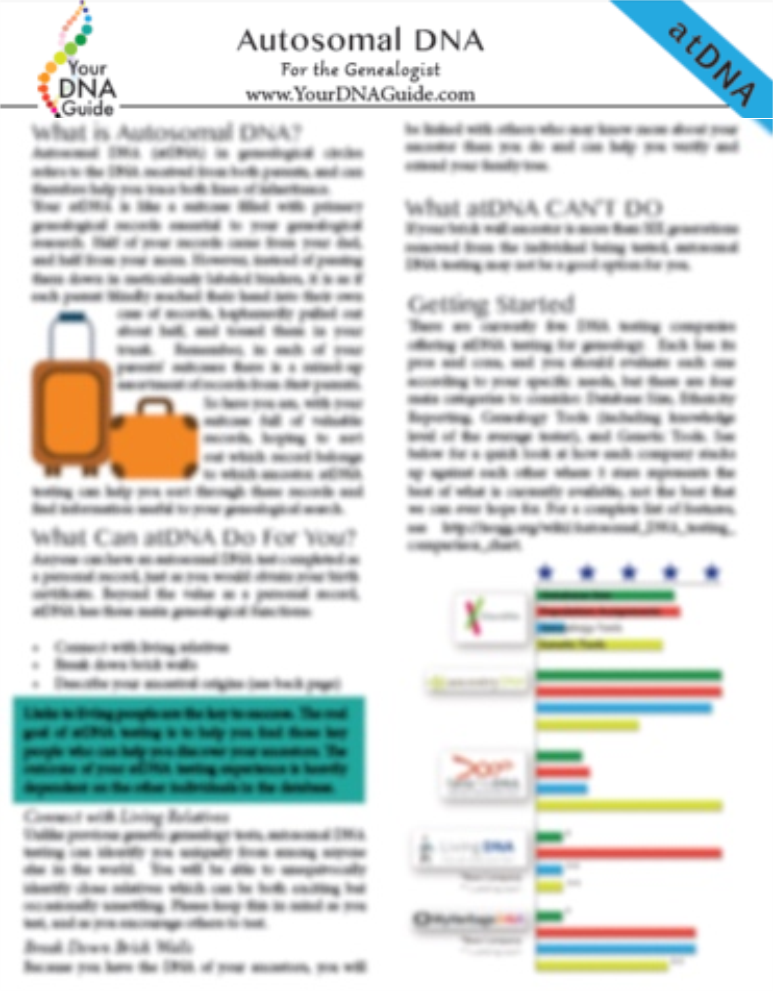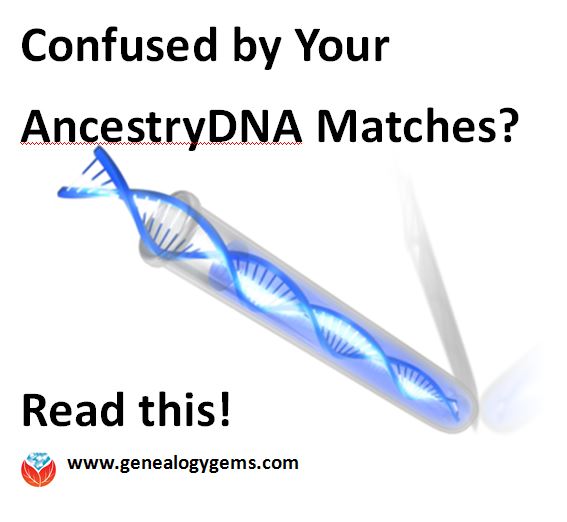by Lisa Cooke | Dec 26, 2015 | 01 What's New, Ancestry, DNA, Trees
DNA Circles at AncestryDNA can get problematic when participants’ trees are unverified. This is why.

Adding people to a family tree without verifying the connection is a fairly common genealogical practice. This happens a lot when people “graft” information from another online tree.
In addition to the problems this can create in your tree, it can create problems when you start looking at genetic connections. We have received a few inquiries about this topic here at Genealogy Gems, and I chatted with a fellow genealogist about this at a recent conference.
The practice of copying online trees factors most heavily in the DNA Circles and New Ancestor Discoveries (NAD) at AncestryDNA. You will remember from our previous conversations that these tools are like parties that your DNA has secured your tickets to attend. Each of these parties is “hosted” by one of your ancestors, in the case of the DNA circle, and a presumed ancestor, in the case of a NAD. Sometimes we catch ourselves declaring that our membership in the DNA circle “proves” our connection to the party host.
But we must be careful. Because it does not.
 “Proves” is too strong of a word. All your membership in the DNA circle can really tell you is that you have a genetic connection to those marked with the orange line. Those with the grey connecting lines have a DNA connection to some of the circle members, but not to you. Placing the name of an ancestor on the cover of this gathering does not guarantee that the named person is your common ancestor. It is just a suggestion; a hint.
“Proves” is too strong of a word. All your membership in the DNA circle can really tell you is that you have a genetic connection to those marked with the orange line. Those with the grey connecting lines have a DNA connection to some of the circle members, but not to you. Placing the name of an ancestor on the cover of this gathering does not guarantee that the named person is your common ancestor. It is just a suggestion; a hint.
Think about this for just a second. Let’s say that Joan does a bit of research and decides that her immigrant ancestor’s father is Marcus Reese, born in 1823 in Wales. She adds this to her pedigree chart. She sees on a census record that he had four children, one of whom shared the name of her ancestor, William, and adds those to her chart as well.
Months later, Charlotte is researching her Mary Reese and sees Mary listed on Joan’s pedigree chart as the child of Marcus. She knows Mary’s father was born in Wales and adds Marcus to her pedigree chart telling herself that she will go back later and double check. And so on.
After a while, we have 7 people all connected back through Marcus and his four children, and they all independently decided to get their DNA tested through Ancestry.com.
Ancestry sees their shared DNA and that they have all listed Marcus Reese as their common ancestor. So they create a DNA circle for the seven of them, with Marcus Reese at the head.
Ancestry did not look at the number of cited sources or the myriad of other genealogical possibilities about how these seven individuals could all be related to each other. It saw a genetic connection and a genealogical hypothesis, and it presented them to you in the form of a DNA circle.
The genetic evidence supports a single common ancestor for these 7 people, but it certainly does not have to be Marcus Reese. You can become more certain as you gather the traditional genealogical evidence that you would in any other case. As your documentation mounts, so will your confidence, with the DNA acting like an invitation to keep searching for further evidence of your connection.
 If you enjoyed this post, you’ll love my series of DNA for genealogy quick guides. Each laminated guide–with quick, clear text that helps you act on what you learn–is targeted to a specific DNA topic, from “Getting Started” to the three types of DNA tests you can take to understanding your results with testing companies AncestryDNA, FamilyTreeDNA and 23andMe. Why not grab the “super bundle” of all 10 guides? You can also shop for them individually here.
If you enjoyed this post, you’ll love my series of DNA for genealogy quick guides. Each laminated guide–with quick, clear text that helps you act on what you learn–is targeted to a specific DNA topic, from “Getting Started” to the three types of DNA tests you can take to understanding your results with testing companies AncestryDNA, FamilyTreeDNA and 23andMe. Why not grab the “super bundle” of all 10 guides? You can also shop for them individually here.
Disclosure: This article contains affiliate links and Genealogy Gems will be compensated if you make a purchase after clicking on these links (at no additional cost to you). Thank you for supporting Genealogy Gems!

by Lisa Cooke | Nov 18, 2015 | 01 What's New, Ancestry, DNA
 “This is huge!” That’s how DNA expert Diahan Southard summed up major advances at AncestryDNA this past year. Her post was huge, too: it landed the #5 spot on our Top 10 genealogy blog posts for 2015 countdown. See why!
“This is huge!” That’s how DNA expert Diahan Southard summed up major advances at AncestryDNA this past year. Her post was huge, too: it landed the #5 spot on our Top 10 genealogy blog posts for 2015 countdown. See why!
To those who have spent a lot of time doing genetic genealogy, bringing up the launch of significant updates to AncestryDNA earlier this year may seem like old news. But it’s not. AncestryDNA is still the only company with fairly advanced tools for integrating your genetic matches with your family tree. That combo is so attractive, they’ve already acquired more than a million samples in their current DNA database–a huge pond in which to fish for genetic matches.
That’s why Diahan’s popular post on updates to AncestryDNA and DNA Circles is still newsworthy. As she explained, “This is really the first time a DNA testing company has so fully integrated genetics and genealogy. We can now find cousins in the database who do not share our particular genetics, but who do share some of the genetics of our common ancestor.”
 Before doing any DNA test, we always encourage genealogists to do their homework. Different tests should be used for different genealogical questions. Each company offers unique tools, perks and sometimes drawbacks for genealogy customers. Unexpected results and unpredictable encounters with genetic relatives may be difficult for some. Diahan’s Autosomal DNA for the Genealogist quick guide can help you find your way. Her other guides include those specific to AncestryDNA and autosomal DNA (the type of DNA they test at Ancestry). Click here to check them out–and see a great value price to bundle her guides.
Before doing any DNA test, we always encourage genealogists to do their homework. Different tests should be used for different genealogical questions. Each company offers unique tools, perks and sometimes drawbacks for genealogy customers. Unexpected results and unpredictable encounters with genetic relatives may be difficult for some. Diahan’s Autosomal DNA for the Genealogist quick guide can help you find your way. Her other guides include those specific to AncestryDNA and autosomal DNA (the type of DNA they test at Ancestry). Click here to check them out–and see a great value price to bundle her guides.
Once you’re ready to try an AncestryDNA test, click here to purchase, and you’ll support the free Genealogy Gem blog and podcast. (Thank you!)
Disclosure: This article contains affiliate links and Genealogy Gems will be compensated if you make a purchase after clicking on these links (at no additional cost to you). Thank you for supporting Genealogy Gems!
by Lisa Cooke | Nov 17, 2015 | 01 What's New, Ancestry, DNA
It’s no surprise to find another DNA post in the #8 spot on our Top 10 genealogy blog post countdown. The topic: understanding your AncestryDNA matches.
In this post, Genealogy Gems resident DNA expert Diahan Southard takes on a confused question sent in by a listener, who didn’t understand why certain people were showing up in her AncestryDNA results.
This post explains SO beautifully a couple of key concepts:
- the difference between your AncestryDNA genetic matches and the DNA Circles/New Ancestry Discoveries that pull from both your genetic results and your family tree; AND
- three reasons someone may show up in your AncestryDNA matches as a New Ancestry Discovery–and which one of those scenarios actually helps your research.
Since running my own autosomal test through AncestryDNA a few months ago, I find myself coming back repeatedly to Diahan’s series of posts to help me  better understand and use those results. I know I’m not alone, since three of Diahan’s DNA posts made our Top 10 this year! (We covered #10 yesterday.)
better understand and use those results. I know I’m not alone, since three of Diahan’s DNA posts made our Top 10 this year! (We covered #10 yesterday.)
Click here to read the above post, and click here to find a list of all DNA-related posts on our genealogy blog.
 If you’ve done your homework and decided that an AncestryDNA test is what should be next for your family history research, thank you for purchasing one by clicking here. Your purchase supports the free Genealogy Gem blog and podcast. (Thank you! YOU are a gem!)
If you’ve done your homework and decided that an AncestryDNA test is what should be next for your family history research, thank you for purchasing one by clicking here. Your purchase supports the free Genealogy Gem blog and podcast. (Thank you! YOU are a gem!)
Disclosure: This article contains affiliate links and Genealogy Gems will be compensated if you make a purchase after clicking on these links (at no additional cost to you). Thank you for supporting Genealogy Gems!
by Lisa Cooke | Jun 25, 2015 | 01 What's New, Ancestry, DNA, images, Listeners & Readers
 Opening your AncestryDNA account to find a New Ancestor Discovery can be a bit like the experience my nine-year old had at the beach today. He noticed something unusual in the sand on his way down to the beach and excitedly used his hands to unearth the treasure. However, it turned out to be a Captain Hook figurine long lost by another (likely much younger) beach-goer. His initial excitement quickly dissipated. He was disappointed as he had clearly found something he did not need or want.
Opening your AncestryDNA account to find a New Ancestor Discovery can be a bit like the experience my nine-year old had at the beach today. He noticed something unusual in the sand on his way down to the beach and excitedly used his hands to unearth the treasure. However, it turned out to be a Captain Hook figurine long lost by another (likely much younger) beach-goer. His initial excitement quickly dissipated. He was disappointed as he had clearly found something he did not need or want.
I have heard from many of you that are confused and disappointed with Ancestry’s attempts to merge your genetics and your genealogy. Keep in mind that AncestryDNA matches are only using your genetics. Your DNA Circles and your New Ancestor Discoveries incorporate your linked tree into your genetic test results.
 Lisa recently forwarded me a comment from Kate that perfectly illustrates the confusion I’m talking about. “We had DNA done thru Ancestry,” she writes. “The results [have] made me seriously question what they are showing me. I believe they are using my tree to show me results that are more vague than they are revealing. The latest example they show is a person not related by blood. This family is related by name only (my uncle’s spouse).
Lisa recently forwarded me a comment from Kate that perfectly illustrates the confusion I’m talking about. “We had DNA done thru Ancestry,” she writes. “The results [have] made me seriously question what they are showing me. I believe they are using my tree to show me results that are more vague than they are revealing. The latest example they show is a person not related by blood. This family is related by name only (my uncle’s spouse).
“My results from Ancestry show that they use my tree to make matches. Just checked the web page for DNA results. They show numerous matches….Three or 4 contacted me because they were convinced they were related by blood when they may have had a remote tree connection. They contacted me because the DNA results showed they were a 3rd or 4th
cousin, when in fact they would only be a 3rd or 4th cousin in my tree.”
I can see why she’s confused. First, let’s review what an AncestryDNA New Ancestor Discovery (NAD) actually IS. NAD’s are based on the DNA Circle idea created by Ancestry. Remember that a DNA circle is when Ancestry can identify a shared genetic AND genealogical connection between three or more people. Using various standards and measures, they name an ancestor as your connection. This is the ancestor I affectionately call our Party Host. This is the ancestor who passed his or her DNA down to all of their descendants, like tickets inviting them to this party in the future. So, everyone who holds a ticket, AND who has honored that party host ancestor by placing their name in their pedigree chart, is listed as a guest in the form of a DNA circle connection. (Click here to read a blog post about this concept.)
The New Ancestor Discoveries just take that one step further. The NAD is an attempt to find ticket holders who have not yet taken that extra step and added that important Party Host ancestor to their family tree. The NAD is like a nudge, inviting us to double check our family tree to see if this particular ancestor might need to be added. It is important to remember that a NAD comes only after a DNA circle has already been formed, and there could have been errors in that formation. So the very first thing you need to do with a NAD is to correspond with circle members and double check that the Party Host of the circle, their common ancestor, is correct. Then we can move on to evaluating the NAD.
Ancestry admits on its help pages that there are three reasons why you might get an NAD, and only one is “right” in the way you and I might view it.
 The “right” answer comes when the DNA circle was drawn correctly, the Party Host properly identified, and your DNA connection is strong to two or more members of the circle. You are then able to verify through traditional genealogical methods that you are an actual descendant of the Party Host, holding that coveted ticket, shown in blue in this modified image from the AncestryDNA help page.
The “right” answer comes when the DNA circle was drawn correctly, the Party Host properly identified, and your DNA connection is strong to two or more members of the circle. You are then able to verify through traditional genealogical methods that you are an actual descendant of the Party Host, holding that coveted ticket, shown in blue in this modified image from the AncestryDNA help page.
There are two other alternatives.
 First, you are related to the NAD Party Host (the New Ancestor that was discovered) via marriage. In this second example from Ancestry’s help page, we see that your ancestor was married twice. The members of the DNA circle are descendants of her other marriage. Remember, that you do not share DNA with every member of the DNA circle. In this case, you share the purple DNA with a few members of the circle. But there are other members that share the blue. So the super computers at Ancestry first put all the blues together in a circle with the Party Host at the top. Then you come along with purple DNA that matches a few in the circle and their supercomputer erroneously assumes that you too must have been invited to this “blue” party, but in fact, the blue/purple members of the circle are double booked. They have been invited to both the blue and the purple party.
First, you are related to the NAD Party Host (the New Ancestor that was discovered) via marriage. In this second example from Ancestry’s help page, we see that your ancestor was married twice. The members of the DNA circle are descendants of her other marriage. Remember, that you do not share DNA with every member of the DNA circle. In this case, you share the purple DNA with a few members of the circle. But there are other members that share the blue. So the super computers at Ancestry first put all the blues together in a circle with the Party Host at the top. Then you come along with purple DNA that matches a few in the circle and their supercomputer erroneously assumes that you too must have been invited to this “blue” party, but in fact, the blue/purple members of the circle are double booked. They have been invited to both the blue and the purple party.
How can you fix this? If you can identify your purple Party Host, then you can add that person to your tree, and the trees of your DNA matches and likely then a new DNA Circle will form with the purple Party Host at its head, and the blue NAD will disappear.
 The other situation that many of you are seeing, especially those of you with ancestry from small communities, is demonstrated in Figure 3 of the Ancestry Help page, reproduced here. As you can see, this one is much more complicated. (In fact, the colors I added aren’t even quite accurate, as not all descendants of the blue NAD have the same blue, but rather different shades of blue depending on the segment they received- but this is a story for another post!)
The other situation that many of you are seeing, especially those of you with ancestry from small communities, is demonstrated in Figure 3 of the Ancestry Help page, reproduced here. As you can see, this one is much more complicated. (In fact, the colors I added aren’t even quite accurate, as not all descendants of the blue NAD have the same blue, but rather different shades of blue depending on the segment they received- but this is a story for another post!)
The short of it is, the members of the previously established DNA circle share one single ancestor with each other, but they share multiple separate and distinct ancestors with you. Looking at this chart it seems very clear, but remember, in the database we only see you and the people you match. We cannot tell from the DNA shared which piece came from which ancestor. So, it is very important to check and double check the pedigrees of those in the circle to identify additional shared lines.
The short of it is, these NAD’s are following the guilt by association rule, but in fact, you could be innocent. Just keep in mind the simple principle that you DO share a common ancestor with those members of the circle that you share DNA with. You do NOT necessarily share common ancestry with those in the circle that you do not share DNA with.
The key is to take these NAD’s for what they really are: research suggestions. Keep your expectations low, and then you will be pleasantly surprised when you are able to verify a connection.
 Ready to learn more about DNA testing for family history? Click here to watch two video interviews in which Lisa and I chat about genetic genealogy.
Ready to learn more about DNA testing for family history? Click here to watch two video interviews in which Lisa and I chat about genetic genealogy.
My DNA quick reference guides can get you started on your own DNA research, or help you unpuzzle and maximize results you don’t fully understand. Click here to see all six guides: purchase them individually or as value-priced bundles.

 “Proves” is too strong of a word. All your membership in the DNA circle can really tell you is that you have a genetic connection to those marked with the orange line. Those with the grey connecting lines have a DNA connection to some of the circle members, but not to you. Placing the name of an ancestor on the cover of this gathering does not guarantee that the named person is your common ancestor. It is just a suggestion; a hint.
“Proves” is too strong of a word. All your membership in the DNA circle can really tell you is that you have a genetic connection to those marked with the orange line. Those with the grey connecting lines have a DNA connection to some of the circle members, but not to you. Placing the name of an ancestor on the cover of this gathering does not guarantee that the named person is your common ancestor. It is just a suggestion; a hint. If you enjoyed this post, you’ll love my series of DNA for genealogy quick guides. Each laminated guide–with quick, clear text that helps you act on what you learn–is targeted to a specific DNA topic, from “Getting Started” to the three types of DNA tests you can take to understanding your results with testing companies AncestryDNA, FamilyTreeDNA and 23andMe. Why not grab the “super bundle” of all 10 guides? You can also shop for them individually here.
If you enjoyed this post, you’ll love my series of DNA for genealogy quick guides. Each laminated guide–with quick, clear text that helps you act on what you learn–is targeted to a specific DNA topic, from “Getting Started” to the three types of DNA tests you can take to understanding your results with testing companies AncestryDNA, FamilyTreeDNA and 23andMe. Why not grab the “super bundle” of all 10 guides? You can also shop for them individually here.

 Before doing any DNA test, we always encourage genealogists to do their homework. Different tests should be used for different genealogical questions. Each company offers unique tools, perks and sometimes drawbacks for genealogy customers. Unexpected results and unpredictable encounters with genetic relatives may be difficult for some. Diahan’s
Before doing any DNA test, we always encourage genealogists to do their homework. Different tests should be used for different genealogical questions. Each company offers unique tools, perks and sometimes drawbacks for genealogy customers. Unexpected results and unpredictable encounters with genetic relatives may be difficult for some. Diahan’s 
 better understand and use those results. I know I’m not alone, since three of Diahan’s DNA posts made our Top 10 this year! (We covered
better understand and use those results. I know I’m not alone, since three of Diahan’s DNA posts made our Top 10 this year! (We covered 









